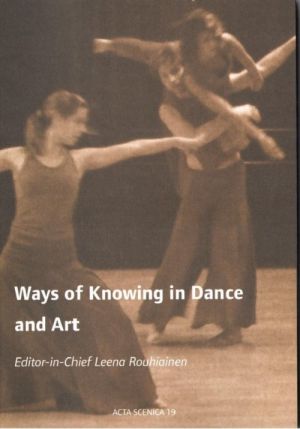Ways of Knowing in Dance and Art addresses bodily knowledge and procedures in the field of dance art as they are understood by a number of dance artists, pedagogues and scholars. During the past decade, practice-based research has won increasing attention by artist-researchers working in the field of dance. What do dancers, choreographers and dance pedagogues know? What is the nature of their practical knowledge and how can it be theorized? How are movement, the body and social conventions and contexts related to this knowledge?
The nine articles of this anthology offer insights into the nature of the bodily knowledge that dance practitioners work with and the meaning this knowledge has in diverse artistic and pedagogic processes. It also introduces views on the challenges and possibilities of exploring bodily knowledge both in practice and by theorizing about it in writing. More particularly, the articles introduce different approaches to the choreographic process, underlining its collaborative and creative features. They offer insight into holistic and socially aware means of teaching dance and empowering the student's agency. In addition, by exploring the nature and meaning of immediate experience as well as emotions in dancing, bodily consciousness is addressed as a form of knowledge that dance practitioners work with. Likewise, the problems and possibilities of writing about the dance experience and doing artistic research are touched upon in several articles.
Finally, the rational paradigm that arts education has traditionally relied upon is criticized and the necessity of educating the senses and the body are demonstrated. In the end, since this anthology contains different views on dance and art by several different authors, it in fact discusses diverse bodily knowledges.
Ways of Knowing in Dance and Art addresses bodily knowledge and procedures in the field of dance art as they are understood by a number of dance artists, pedagogues and scholars. During the past decade, practice-based research has won increasing attention by artist-researchers working in the field of dance. What do dancers, choreographers and dance pedagogues know? What is the nature of their practical knowledge and how can it be theorized? How are movement, the body and social conventions and contexts related to this knowledge?
The nine articles of this anthology offer insights into the nature of the bodily knowledge that dance practitioners work with and the meaning this knowledge has in diverse artistic and pedagogic processes. It also introduces views on the challenges and possibilities of exploring bodily knowledge both in practice and by theorizing about it in writing. More particularly, the articles introduce different approaches to the choreographic process, underlining its collaborative and creative features. They offer insight into holistic and socially aware means of teaching dance and empowering the student's agency. In addition, by exploring the nature and meaning of immediate experience as well as emotions in dancing, bodily consciousness is addressed as a form of knowledge that dance practitioners work with. Likewise, the problems and possibilities of writing about the dance experience and doing artistic research are touched upon in several articles.
Finally, the rational paradigm that arts education has traditionally relied upon is criticized and the necessity of educating the senses and the body are demonstrated. In the end, since this anthology contains different views on dance and art by several different authors, it in fact discusses diverse bodily knowledges.













